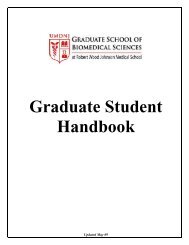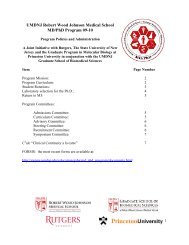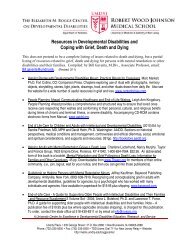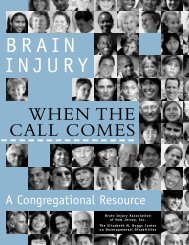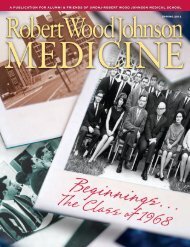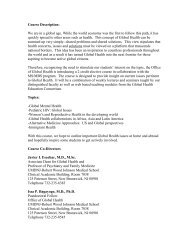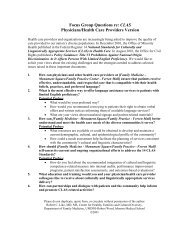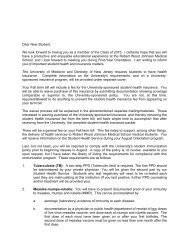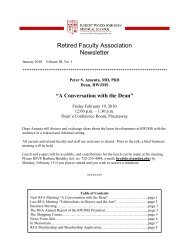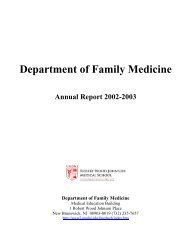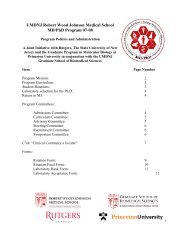Robert Wood Johnson Medicine • Spring 2011 • Population Science
Robert Wood Johnson Medicine • Spring 2011 • Population Science
Robert Wood Johnson Medicine • Spring 2011 • Population Science
Create successful ePaper yourself
Turn your PDF publications into a flip-book with our unique Google optimized e-Paper software.
further testing such as<br />
amniocentesis that can clarify the risk, and discuss<br />
the risks and the treatments available for children<br />
with the disorder. We try to give a clear picture of<br />
what the future holds for them, but ultimately, the<br />
decision is theirs.”<br />
Dr. Brooks and her team provide screening and<br />
testing for fragile X, Tay-Sachs disease, cystic fibrosis,<br />
and many other genetic disorders. Because a<br />
person can carry a genetic disorder without exhibiting<br />
symptoms, pre-conception screening of both<br />
parents may prevent the conception of a profoundly<br />
disabled or very sick child. When there is a history<br />
of mental retardation in a family, it is important<br />
to test for fragile X, the most common form of<br />
intellectual disability, because women can be carriers<br />
without exhibiting symptoms. While fragile X<br />
causes mental retardation, it may not be diagnosed<br />
in a child until he or she is three or four years old;<br />
by then, other siblings may have been born with the<br />
disorder.<br />
Sometimes, prenatal diagnosis can prepare both<br />
the clinical team and the parents for treatment that<br />
starts before, at, or soon after delivery. For example,<br />
prenatal testing because of family history may<br />
show that a baby has a genetic disorder of metabolism.<br />
In such cases, nutritional supplements may be<br />
needed at birth, to reduce the risk of mental retardation<br />
or learning problems and improve the child’s<br />
chances of survival. A baby with Down syndrome is<br />
at particularly high risk for heart defects. Whenever<br />
there is a risk of a baby being born with a heart<br />
defect, a pediatric cardiologist is alerted as soon as<br />
the mother’s labor begins and is on call to check the<br />
newborn immediately and recommend appropriate<br />
treatment. M<br />
Supplementing the neonatologists are additional clinicians<br />
who specialize in treating children, including newborns:<br />
pediatric cardiologists; ear, nose, and throat specialists;<br />
rheumatologists; gastroenterologists; neurologists;<br />
nephrologists; and pharmacologists. Everyone on<br />
the nursing team is neonatology-certified. Nutritionists<br />
track the newborns’ growth, respiratory therapists help<br />
them breathe, physical therapists see to the special physical<br />
needs of babies who might spend their days lying in<br />
bed, and speech therapists help them learn how to feed<br />
and swallow. Social workers help parents adjust to the<br />
stress of having a sick baby and assist in planning for the<br />
weeks and months ahead.<br />
After going home, babies return to the NICU every six<br />
months for assessment in a comprehensive developmental<br />
clinic co-sponsored by the medical school and the<br />
hospital. Many RWJMS faculty specialists serve at the<br />
clinic, which is led by neonatologist Thomas Hegyi, MD,<br />
professor of pediatrics, and pediatric psychologist<br />
Barbara M. Ostfeld, PhD, professor of pediatrics. Dr.<br />
Hegyi and Dr. Ostfeld also serve, respectively, as medical<br />
director and program director for the Sudden Infant<br />
Death Syndrome Center of New Jersey. For questions in<br />
between scheduled clinics, parents may phone Catherine<br />
Amato-Bowden, MSN, APN-BC, coordinator, high-risk<br />
infant follow-up program, The Bristol-Myers Squibb<br />
Children’s Hospital at RWJUH.<br />
The Reproductive <strong>Science</strong>s<br />
Reproductive Endocrinology:<br />
<strong>Science</strong> Verging on <strong>Science</strong> Fiction<br />
he size of the division of reproductive<br />
T endocrinology and infertility reflects the<br />
rapid expansion of this growing science and<br />
its strong presence at RWJMS. With 180 clinical and<br />
support staff, covering every aspect of the field, the division<br />
is larger than most OB/GYN departments, says its<br />
director, Richard T. Scott, MD, professor of obstetrics,<br />
gynecology, and reproductive sciences.<br />
“The field is way ahead of where it was 30 — or even<br />
15 — years ago,” adds Dr. Scott. “Still, one couple in<br />
every six deals with infertility issues, and, with the<br />
prevalence of delayed pregnancy, the numbers are<br />
increasing.” Increased precision in screening and significant<br />
advances in in vitro techniques are making pregnancy<br />
possible for many couples with fertility issues or<br />
<strong>Robert</strong> <strong>Wood</strong> <strong>Johnson</strong> ■ MEDICINE 25



